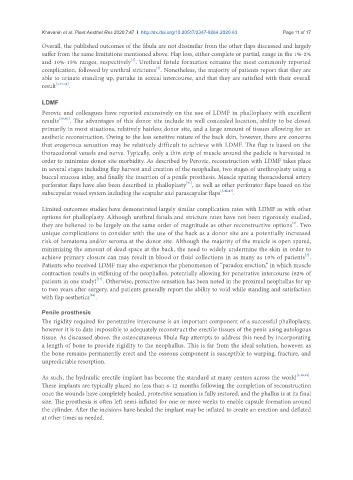Page 540 - Read Online
P. 540
Khavanin et al. Plast Aesthet Res 2020;7:47 I http://dx.doi.org/10.20517/2347-9264.2020.63 Page 11 of 17
Overall, the published outcomes of the fibula are not dissimilar from the other flaps discussed and largely
suffer from the same limitations mentioned above. Flap loss, either complete or partial, range in the 1%-2%
[3]
and 10%-15% ranges, respectively . Urethral fistula formation remains the most commonly reported
[3]
complication, followed by urethral strictures . Nonetheless, the majority of patients report that they are
able to urinate standing up, partake in sexual intercourse, and that they are satisfied with their overall
result [3,37,38] .
LDMF
Perovic and colleagues have reported extensively on the use of LDMF in phalloplasty with excellent
results [39,40] . The advantages of this donor site include its well concealed location, ability to be closed
primarily in most situations, relatively hairless donor site, and a large amount of tissues allowing for an
aesthetic reconstruction. Owing to the less sensitive nature of the back skin, however, there are concerns
that erogenous sensation may be relatively difficult to achieve with LDMF. The flap is based on the
thoracodorsal vessels and nerve. Typically, only a thin strip of muscle around the pedicle is harvested in
order to minimize donor site morbidity. As described by Perovic, reconstruction with LDMF takes place
in several stages including flap harvest and creation of the neophallus, two stages of urethroplasty using a
buccal mucosa inlay, and finally the insertion of a penile prosthesis. Muscle sparing thoracodorsal artery
[41]
perforator flaps have also been described in phalloplasty , as well as other perforator flaps based on the
subscapular vessel system including the scapular and parascapular flaps [3,42,43] .
Limited outcomes studies have demonstrated largely similar complication rates with LDMF as with other
options for phalloplasty. Although urethral fistula and stricture rates have not been rigorously studied,
[3]
they are believed to be largely on the same order of magnitude as other reconstructive options . Two
unique complications to consider with the use of the back as a donor site are a potentially increased
risk of hematoma and/or seroma at the donor site. Although the majority of the muscle is open spared,
minimizing the amount of dead space at the back, the need to widely undermine the skin in order to
[3]
achieve primary closure can may result in blood or fluid collections in as many as 10% of patients .
Patients who received LDMF may also experience the phenomenon of “paradox erection,” in which muscle
contraction results in stiffening of the neophallus, potentially allowing for penetrative intercourse (82% of
[44]
patients in one study) . Otherwise, protective sensation has been noted in the proximal neophallus for up
to two years after surgery, and patients generally report the ability to void while standing and satisfaction
[44]
with flap aesthetics .
Penile prosthesis
The rigidity required for penetrative intercourse is an important component of a successful phalloplasty,
however it is to date impossible to adequately reconstruct the erectile tissues of the penis using autologous
tissue. As discussed above, the osteocutaneous fibula flap attempts to address this need by incorporating
a length of bone to provide rigidity to the neophallus. This is far from the ideal solution, however, as
the bone remains permanently erect and the osseous component is susceptible to warping, fracture, and
unpredictable resorption.
As such, the hydraulic erectile implant has become the standard at many centers across the world [3,19,45] .
These implants are typically placed no less than 6-12 months following the completion of reconstruction
once the wounds have completely healed, protective sensation is fully restored, and the phallus is at its final
size. The prosthesis is often left semi-inflated for one or more weeks to enable capsule formation around
the cylinder. After the incisions have healed the implant may be inflated to create an erection and deflated
at other times as needed.

